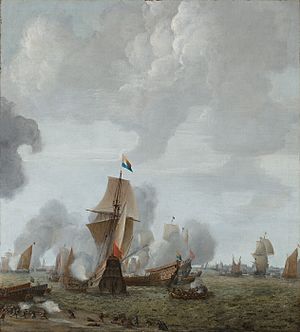Battle of the Slaak facts for kids
Quick facts for kids Battle of the Slaak |
|||||||
|---|---|---|---|---|---|---|---|
| Part of the Eighty Years' War | |||||||
 Battle at the Slaak, 12 and 13 September 1631 |
|||||||
|
|||||||
| Belligerents | |||||||
| Commanders and leaders | |||||||
| Strength | |||||||
| 5,500 soldiers, 35 ships, 60 vessels |
50 vessels | ||||||
| Casualties and losses | |||||||
| 80 vessels sunk, destroyed or captured, 1,500 killed, wounded or drowned, 4,000 prisoners |
Light | ||||||
The Battle of the Slaak was an important naval battle. It happened on September 12 and 13, 1631. The Dutch won this battle during the Eighty Years' War. This victory stopped the Spanish army from splitting the Dutch Republic into two parts.
Why the Battle Happened
Spain's Plan to Divide the Dutch Republic
Earlier in 1631, the Dutch tried to capture the city of Dunkirk by land. In response, Infanta Isabella Clara Eugenia of Spain planned a surprise attack. She was the ruler of the Southern Netherlands for Philip IV of Spain. She ordered a Spanish army to travel by ship. Their goal was to take over the islands of Goeree and Overflakee.
Strategic Importance of the Islands
The Spanish especially wanted to capture the strong forts near the Volkerak Strait. One fort was in a new town called Willemstad. This town was named after William the Silent, a Dutch hero. Taking Willemstad would have been a big win for Spain. More importantly, if Spain held these islands, they could block Hellevoetsluis. This was the main Dutch naval port. It would also cut off the province of Zeeland from the rest of the Dutch provinces.
The Battle Begins
Spanish Fleet Sets Sail
A large Spanish fleet left the city of Antwerp. It had 90 ships and 5,500 soldiers. Don Francisco de Moncada, the Marquis of Aytona, was in charge. But the actual commander was Count Jan van Nassau Siegen. He was a Catholic cousin of the Dutch House of Orange. Most of the Spanish ships were small transport barges.
Dutch Prepare for Defense
The Spanish plan was not a secret for long. The Dutch quickly put together their own fleet. It had 50 ships, mostly small river boats. Some larger ships called flyboats were also part of the fleet. Vice-Admiral Marinus Hollare from Zeeland led the Dutch forces. They waited for the Spanish fleet in the Eastern Scheldt.
Spanish Attempts to Land
The Spanish saw their path was blocked. They first tried to capture the island of Tholen instead. They wanted to show some success from their efforts. But this attempt failed. A group of 2,000 English and Scottish soldiers stopped them. These soldiers were led by Colonel Thomas Morgan. They marched through the shallow sea from the fort of Steenbergen. They arrived just in time to prevent the Spanish from landing.
A Risky Night Maneuver
Count van Nassau was desperate. He made a bold decision. He tried to sneak his fleet past the Dutch during the night. He hoped to reach the original target after all.
The Dutch Counterattack
Surprise Attack in the Fog
Even with a fog, the Dutch noticed the Spanish movement. The Dutch fleet was smaller, but they were smart. They let the entire Spanish fleet pass them. Then, they suddenly attacked the Spanish from behind. This happened in the Slaak of Volkerak channel. The Spanish fleet was completely surprised and defeated.
Spanish Defeat and Capture
Hundreds of Spanish soldiers drowned trying to escape their ships. Those who made it to shore were captured by Dutch and English troops. Over 4,000 soldiers and sailors were taken prisoner. Most of the Spanish ships were sunk, destroyed, or captured. Count van Nassau and two ships managed to escape back to Antwerp. It is not known exactly how many others escaped. Perhaps about a third of his fleet got away.
After the Battle
Fate of the Prisoners
After the battle, there was a discussion about what to do with the prisoners. The Admiralty of Amsterdam suggested a very harsh method. They wanted to throw all prisoners into the sea. This was sometimes done to stop future attacks. But stadtholder Frederick Henry of Orange strictly forbade this.
Heroes of the Battle
Two captains who fought bravely were brothers. They were Johan Evertsen and Cornelis Evertsen de Oude. Both later became important admirals.
Impact on the War
The defeat at Slaak was one of many setbacks for the Habsburg rulers. They were also fighting the Thirty Years War in Germany at the same time. This loss influenced them to try for peace talks with the Dutch Republic in 1632. However, these peace talks did not succeed.


